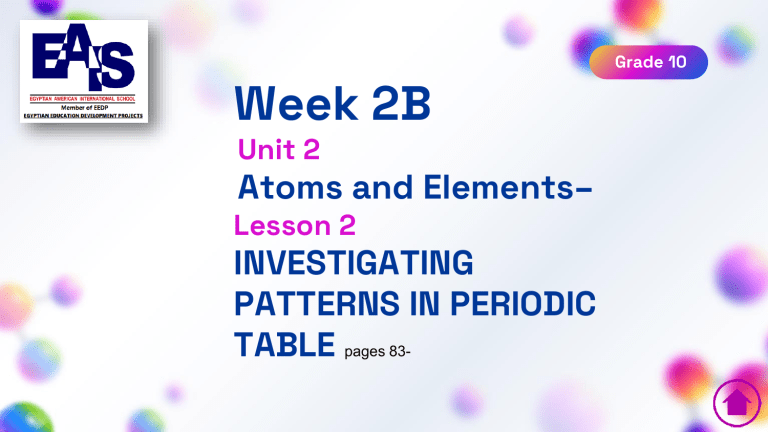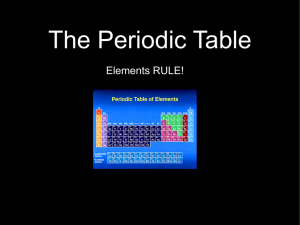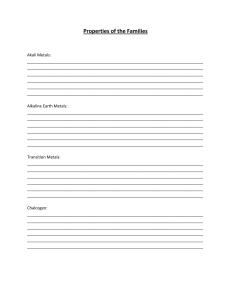
Grade 10 Week 2B Unit 2 Atoms and Elements– Lesson 2 INVESTIGATING PATTERNS IN PERIODIC TABLE pages 83- Instructions for use Dear Students, Please follow the guided lesson power point presentation that covers all your lesson, activities, pract6ices and Lab . Always use your notebook to take notes while reading, listening, watching videos and audios. Digital lessons and games linked inside it by clicking the video/audio image in the slides. Throughout the ppp you will have Concept checks, lesson activity, practice and Lab. By the end of which , you will be able to do the standardized testing practice successfully to ensure your understanding and readiness for your standardized test. Lesson will be addressed through at home study and in Class sessions. What should I do and when Before class: Watch the video and be ready with your questions for the class discussion During class: 11. Watch the video and be ready with your questions for the class discussion 2. Participate in the class discussion through think and share 3. In-class practice 4. Do the lesson activity After class: AT home practice and take notes of any inquiry you have to share with your teacher via message on Edmodo or during office hour . Lesson and learning Objective Explore patterns in the periodic table and use them to make predictions about the behavior of elements. Analyze how periodic table is organized. Identify the patterns of the periodic table. Use periodic table to discover properties of elements and locate them. Vocabulary covered PERIODIC TABLE NGSS connection HS-PS1-1 Watch this video before coming to school it will introduce you to Topics name : History of periodic table Video Link: https://www.youtube.com/watch?v=ogpWoB4m-Ns Topics name : Trends in the periodic table Video Link: https://www.youtube.com/watch?v=Q4rW0fvkt2g Topics name : the genius of Mendeleev video Video Link: https://video.link/w/qpfic Presentation Guide Lesson will be addressed as follows : 01 02 SESSION SESSION 03 04 SESSION SESSION Lesson Practice 01 SESSION Activity rubrics 02 SESSION How can we study all these animals in an easy way? BY classifying them into groups By the Same way the scientists started to study the elements known !!! 1869: Dimitri Mendeleev arranged the known elements in order of mass but he also left in gaps and was able to predict the properties of unknown elements: Li Be B C N O F Na Mg Al All of the elements in the same group have similar PROPERTIES. This is how I thought of the periodic table in the first place. This is called PERIODICITY. Mendeleev arranged the elements so the atomic mass increased going down a column. He arranged the columns so elements in the same row shared similar properties. Mendeleev was organizing the elements by both their atomic mass and by patterns in their properties. He had to leave gaps in order to fit the known elements into this pattern. He predicted that each gap represented an undiscovered element. Mendeleev’s table of elements revealed a repeating pattern, or periodicity, of properties, hence the name periodic table. Rutherford Discovered that the nucleus contains Protons (Atomic number) 1913: Henry Moseley proposed the use of atomic number rather than atomic mass. Knowledge of the existence of isotopes also gave evidence to using proton number rather than mass. Vertical columns are called GROUPS 92 natural element Horizontal rows are called PERIODS Press on this icon to view the periodic table in full-screen mode Mosely arranged the elements according to increasing atomic number The difference between the atomic no. of the element and the previous one is (one). Periodic Law They are arranged in specific • 7 horizontal rows called periods • 18 vertical columns called groups Adjacent elements in a period may have similar or different properties elements in the same group have similar properties 03 SESSION Valence electrons (outermost electrons) Most easily gained or lost electrons during chemical reaction ( when atoms react together) They determine the properties of an element *location of element on the periodic table Metals are characterized by having 1, or 2 or 3 electrons in their outermost energy levels. -Metals of group 1 have only 1 electron in their outermost energy level. -Metals of group 2 have only 2 electrons in their outermost energy level. -Metals of group 3 have only 3 electrons in their outermost energy level. -So, ALL METALS lose electrons to form positive ions (cations). Non metals usually contain 5 or 6 or 7 electrons in their outermost energy level depending on the GROUP NUMBER. • Nonmetal atoms usually gain electrons to have completely filled outermost energy level. -nonmetal gain electrons to form Negative ions ( anions) • These elements are metals This line divides metals from non-metals These elements are nonmetals 04 SESSION Watch the video to answer the following questions in your science binder: 1. 2. 3. 4. What are the physical properties of group 1 What are the special group names for group 1,2 ,17 and 18? What is the difference between G1 and G2 elements? Why group 18 elements are unreactive? Classification of the Periodic Table Groups with special names: -Group 1 is called Alkali metals. -Group 2 is called Alkaline Earth metals. -Group 7A (17) is called halogens. -Group 8A (18) is called Noble gases. -Groups from 3 to 12 are called Transition metals Group 1 Very reactive Alkali metals Low melting point Alkaline earth metals Metals transition metals • The lanthanides are shiny, reactive, and soft. • Actinides are radioactive, and most are synthetic elements. Group 2 High melting point Less reactive than alkali metals Group 3 to 12 Less reactive More brittle Poor conductors Lanthanides Actinides Most nonmetals are • Gases at normal temperatures • but as solids they tend to be dull, brittle, and poor conductors of heat and electric current. Non Metals Group 17 Extremely reactive Halogens Toxic Colorful gases Nobel gases Group 18 Inert gases (don’t react) Metalloids have properties of both metals and nonmetals Dull and brittle Metalloids Shiny and malleable Semiconductors 5 SESSION In class practice #1 If times allow you do this practice using the code given by your teacher Please go to Edmodo and solve • CCQ Wk 2B • PRACTICE WK2B (Khan Academy ) https://www.khanacademy.org/science/biology/chemistry-of-life/elements-and-atoms/e/atomic-structure Thanks! Do you have any questions? CREDITS: This presentation template was created by Slidesgo, including icons by Flaticon and infographics & images by Freepik Please keep this slide for attribution







